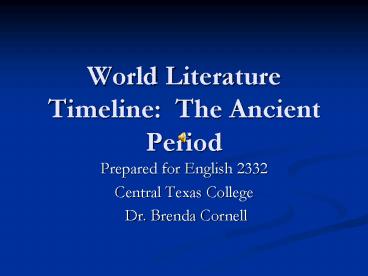World Literature Timeline: The Ancient Period PowerPoint PPT Presentation
1 / 14
Title: World Literature Timeline: The Ancient Period
1
World Literature Timeline The Ancient Period
- Prepared for English 2332
- Central Texas College
- Dr. Brenda Cornell
2
B. C. E. (Before Common Era) 7000-2000
- 7000-1500 Farming communities mother goddesses
were worshipped weaving and metallurgy were some
of the early art forms practiced.
3
3500-3000 Beginning of Cities
- Sites along the Tigris and Euphrates Rivers of
Mesopotamia ( Greek for between the rivers),
which is now Iraq, and the Nile River in Egypt
founded the first cities. - Though primitive societies, these cities saw
important developments in irrigation,
mathematics, calendars, bureaucracies, and
patriarchal institutions.
4
Ziggurats
- These structures stood in front of a temple as a
kind of sanctuary to the gods. In addition to
its religious function the ziggurat also served
as a granary and/or storehouse for other valuable
goods.
5
Farming
- The inhabitants of Mesopotamia raised crops on
this rich but dry land by developing and using
complex irrigation systems so successful that
they resulted in a surplus of food.
6
Feeding the People
- A societys ability to produce food was one of
the most fundamental criteria for the development
from tribal and nomadic hunter-gatherer societies
to more sedentary civilizations. It was possible
only with the development of a number of
significant innovations in early science, such as
in astrology and astronomy (at that time not as
separate as they are seen today).
7
Feeding the People (Continued)
- Without the ability to organize workers according
to reliable patterns beyond day and night, like
the measurement and organization of the seasons
or the use of heliacal stars to increase the
precision of the agricultural year, the
consistent production of a food surplus would not
have been as effective.
8
No Boundaries
- Since Mesopotamia had no natural boundaries (such
as mountain ranges or large rivers), the
inhabitants were physically and psychologically
open to external cultural influences. The
advantage was Mesopotamias stature as one of the
first significant multicultural societies in
history. It boasts 3,000 years of development
and 4 major periods under different ruling groups
(Sumerian, Babylonian, Assyrian, and Persian).
9
Mother of Culture
- Mesopotamias culture also influenced its
neighbors the Egyptians, the Ancient Hebrews,
and, to the east, India. Furthermore, the
domestication of wild plants and animals was
accomplished in Mesopotamia around 8500 B.C.E.,
well before any other nascent civilization. We
might call Mesopotamia the mother of
civilization and culture.
10
Women in Mesopotamia
11
Rules for Women
- During the earliest period, the Sumerian women
enjoyed the greatest social and sexual freedom,
although their strongest and most respected
positions were within the temple, as priestesses,
caretakers, or temple concubines. Each year they
enacted the sacred marriage rite of the fertility
goddess Inanna and the high priest or king
represented the god. Such sexual freedom did not
extend throughout the society. Adultery was
punishable by death and a woman's social "value"
was based on the number of her children.
12
Beginning of Writing Cuneiform
- History (from the Greek historía meaning
"investigation") relies on written records. The
invention of cuneiform writing in Mesopotamia
empowered humans to hold onto aspects of their
past in a form other than the fluid tales of the
oral poet. With the recording of those stories,
the development of mythology, cosmology,
metaphysics, philosophy, literature, and other
valuable pursuits was established.
13
Nonliterary Messages
- Pottery, sculpture, and other artworks can tell
us just as much about a culture as its written
records. They can help bring life to the dry
facts of royal succession, wars, trade disputes,
and laws. Museums and libraries are intended to
protect these priceless objects and keep them for
posterity. By giving everyone the chance to view
records of the past, as well as specialists a
place to work and advance prior scholarships,
they allow a community to publicly question and
understand its past.
14
Works Cited
- Mesopotamia The Formation of Cities and the
Earliest Literatures . World Literature Online.
20 Aug 2006. http//bcs.bedfordstmartins.com/worl
dlit/default.asp?b1criuid0rau0

